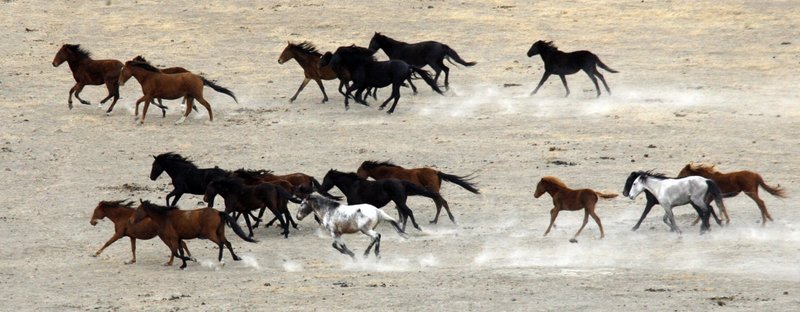SEATTLE – Horse people in the Northwest hope the new year will bring a solution to an old problem: too many horses.
A horse summit planned for next week is expected to draw representatives from tribes, federal agencies and conservation groups, as well as wildlife advocates vexed by too many horses with no market to cull the herds.
“It’s bad and getting worse,” said Sue Wallis, a Wyoming legislator and member of United Horsemen, a Wyoming-based nonprofit organizing the summit. She backs development of a plant in Wyoming where horses can be slaughtered for human consumption — a solution she says is the humane and ethical solution to the problem.
“We are not just some meat-industry schmucks,” she said of slaughter supporters. “What we need is humane and regulated horse processing in the U.S. where we can control it, and we can set really high standards. We are horse people concerned about the well being of the horse.”
TOO MANY HORSES
The horse has proved tricky to reckon with. Neither wildlife nor livestock intentionally grown for slaughter, growing horse populations have defied a solution since the U.S. slaughter industry for horses was shut down in 2007 by animal-rights activists.
Populations have been building ever since. Today, horses are trucked to Canada and Mexico for slaughter, and many more are overpopulating public and tribal lands, to the detriment of wildlife, native plants and the health of the range.
The Bureau of Land Management estimates it has nearly 12,000 more horses on its lands than the range can support, and the agency is feeding more than 11,400 animals kept in corrals it can’t find adopters for.
The BLM spent $36.9 million in 2010 alone just to feed and care for horses it has rounded up and confined in corrals and put out to pasture in long-term holding facilities in the Midwest. And the cost is going up.
The land is also suffering.
“(Horses) are beating it up so much we have no growth coming back,” said David Blodgett Jr, a wildlife technician for the Yakama Nation. “It is having a big impact on our traditions and culture, our big animals, our roots, our fish, they are all part of that circle that is part of our culture.
In the past, the tribe lived in balance with these herds. Originally of Spanish origin, the herds today include descendants of domestic animals turned out by homesteaders, and lately, horses dumped by people too hammered by the recession and high cost of hay to keep their animals.
Tribal members do what they can to control the population, using a battered pickup for horse roundups.
The idea is to herd some of the horses into a temporary corral and once captured, sell them as saddle or pack animals and for slaughter — the most likely outcome.
The tribe’s pros at this tricky work — horse chasers for generations — used to do it all by horseback, “but our insurance lady won’t let us do that anymore,” Blodgett said. Crushed fingers, broken eye sockets, thumbs bitten off “just at the end,” he noted. “It gets a little wild out here sometimes.”
ROADBLOCKS TO SLAUGHTER
First floated publicly in the spring of 2009, the idea of a tribal horse-processing facility is controversial, and runs into regulatory and legal roadblocks, from food-safety concerns to international trade and the federal-inspection question.
There is also widespread popular opposition in a country long wedded to a romantic notion of the wild horses of the West. “Horses are not food animals in this country; they are companions,” said Scott Beckstead, Oregon state director for the Humane Society of the United States.
“My guess is they are scrambling to find a way to make it feasible, but they are fighting against the tide of public opinion,” Beckstead said.
Tribal members interested in the possibility of a processing facility hope the BIA study will help them determine if the idea is economically and legally viable, said Smith of Warm Springs, who is range and agricultural land manager for his tribe.
“We are looking at whether this is economic for Indian Country,” Smith said of a processing facility. “The horse population definitely needs some control and management, but right now it is a tough deal with existing markets. The horse markets are at rock bottom, I don’t know that they can get any worse.”
At the Yakama reservation, the tribe doesn’t have the luxury like the BLM of buying food for surplus horses at taxpayer expense. The horses eat exclusively on tribal rangeland.
On one ridge, a fence divides a lushly vegetated sweep of land from grassland open to grazing, bitten to the ground.
Even with more rain than usual this season, time isn’t healing this landscape, Stephenson said, as he bumped over dirt roads crisscrossing the back country of the reservation, where horses stippled the hills.
“There needs to be a solution.”
Send questions/comments to the editors.



Success. Please wait for the page to reload. If the page does not reload within 5 seconds, please refresh the page.
Enter your email and password to access comments.
Hi, to comment on stories you must . This profile is in addition to your subscription and website login.
Already have a commenting profile? .
Invalid username/password.
Please check your email to confirm and complete your registration.
Only subscribers are eligible to post comments. Please subscribe or login first for digital access. Here’s why.
Use the form below to reset your password. When you've submitted your account email, we will send an email with a reset code.